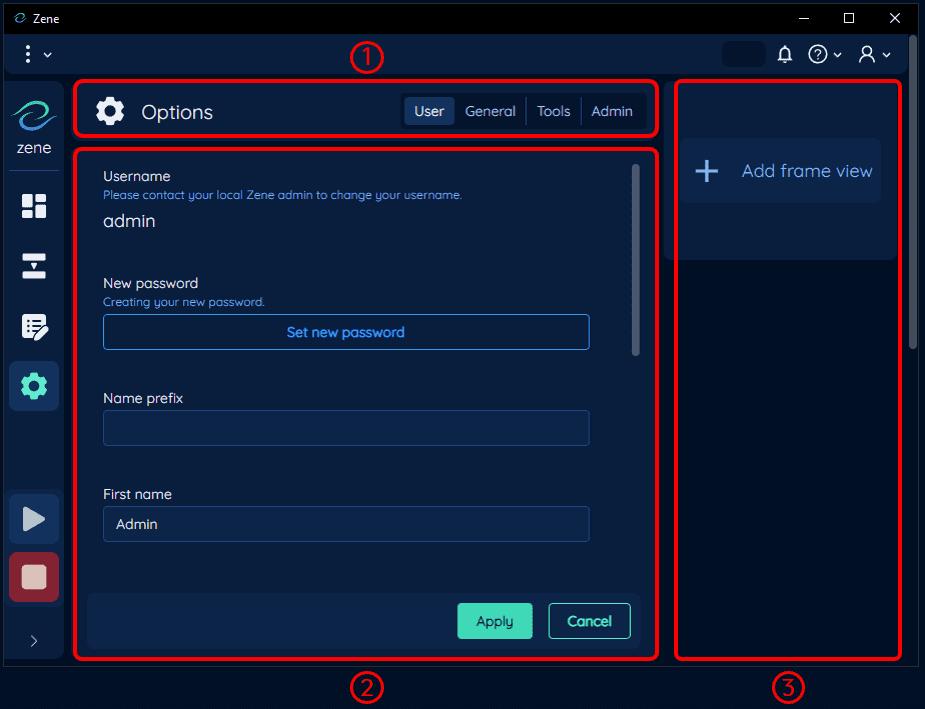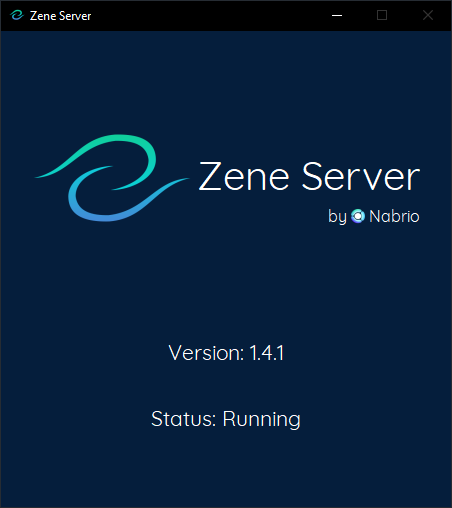Options
Overview

Header and Tabs
Number: 1
Allow users to navigate to other option tabs. The following tabs are available:
Option Setting Area
Number: 2
Allow users to configure the settings of the options.
Frame View Area
Number: 3
This is the area where the frames are displayed. See Frame View for more information.
User
Username
Display the username of the current user.
User cannot change their username here. It must be done within the Admin page by the user with the Admin role.
New Password
Create a new password for the current user.
Set The New Password
- Click the
Set new passwordbutton.
- Enter the user's current password in the
Current passwordfield. - Enter the user's new password in the
New passwordfield. The password must be:- at least 6 characters long
- include at least one number
- include at least one lowercase letter
- include at least one uppercase letter
- include at least one special character
- Enter the user's new password again in the
Confirm new passwordfield.
- Click the
Set passwordbutton.
User Information
The user can edit their information here. The following information can be edited:
- Name Prefix
- First Name
- Middle Name
- Last Name
- Job Title
- Email Address
- Phone Number
General
Server Port
Server backend port number. Required Zene back-end to restart to take effect.
The default port number for Zene server is 19010.
HTTP Port
HTTP port number. Required Zene back-end to restart to take effect.
The default port number for Zene HTTP server is 19011.
Start server at startup
Whether to start Zene server when start the computer.
Run last project at startup
Whether to run the last saved or opened project at start up. This will load the last project and start the server.
Load last project at startup
Whether to load the last saved or opened project at start up. If the Run last project at startup is true, this setting will also be true.
Restart app after a crash
Whether to automatically restart the app after a crash. Requires Zene to restart to take effect.
Show server UI

Whether to show the server information UI.
Hardware Acceleration
Hardware acceleration backend mode for Zene. The following hardware acceleration backends are available:
- None: No hardware acceleration, use CPU only.
- CUDA: Use NVIDIA CUDA for hardware acceleration.
Critical alert notification mode
The critical alert UI notification mode. The following notification modes are available:
- Hidden: Do not show the UI notification.
- Auto close: Show the UI notification and automatically close it after 5 seconds.
- Manual close: Show the UI notification and wait for the user to close it. (Recommends for critical alerts)
Warning alert notification mode
The warning alert UI notification mode. The following notification modes are available:
- Hidden: Do not show the UI notification.
- Auto close: Show the UI notification and automatically close it after 5 seconds. (Recommends for warning alerts)
- Manual close: Show the UI notification and wait for the user to close it.
Information alert notification mode
- Hidden: Do not show the UI notification.
- Auto close: Show the UI notification and automatically close it after 5 seconds. (Recommends for information alerts)
- Manual close: Show the UI notification and wait for the user to close it.
Error Logs Format
The format of the error logs. The following error logs formats are available:
- .csv: Comma-separated values format.
- .txt: Text format.
Display Frame Size
The frame size to be displayed in the Frame View.
The default frame size is 1280x720, this is a good balance between performance and quality. The larger the frame size, the more resources are required to display the frame, which can affect the performance of Zene.
Auto Save Interval
The interval to automatically save the current flow, in minutes. The default value is 5 minutes.
Auto saves files are saved in the autosaves folder in the Zene folder.
- Windows:
Documents(for exampleC:\Users\{YOUR USER NAME}\Documents\Nabrio\Zene 1\autosaves).
Auto Save Delete Interval
The interval to automatically delete the old auto save files, in days. The default value is 14 days.
Tools
Export Image files
Global settings applies to all the Exported Image tools.
Image Compression
Export image compression level (0%: No compression - 100%: Max compression). The default value is 5%.
Auto Delete
Automatically delete the exported image files after the specified time duration or time interval. The default value is false.
Delete Time Interval
The time interval to automatically delete the exported image files.
Delete Time Duration
The time duration (time unit) to automatically delete the exported image files.
Export text files
Global settings applies to all the Exported Text tools.
Auto Delete
Automatically delete the exported text files after the specified time duration or time interval. The default value is false.
Delete Time Interval
The time interval to automatically delete the exported text files.
Delete Time Duration
The time duration (time unit) to automatically delete the exported text files.
Trigger
For more details on the Trigger Tool, see Input Trigger Tool.
With MQTT subscription
Whether to subscribe to MQTT topics.
MQTT protocol
MQTT broker connection protocol. The following protocols are available:
- TCP/IP
- SSL/TLS
- WSS
MQTT host
MQTT broker hostname or IP address.
MQTT port
MQTT broker port number.
MQTT username
MQTT broker username.
MQTT password
MQTT broker password.
MQTT Subscription topic
The topic for the MQTT trigger to subscribe to.
MQTT clean session
Whether to start a clean session for the MQTT connection. If true, the broker will not persist any previous session state.
Subscription last will topic
This is the topic that the broker will publish to when the client disconnects unexpectedly.
Subscription last will payload
This is the message that the broker will publish to the last will topic.
Subscription last will QoS
This is the QoS level at which the broker will publish the last will message.
Subscription last will retain
Whether the broker will retain the last will message.
Email
Global settings applies to all the Email tools.
Address
Sender email address.
Password
Sender email password.
Provider
Email provider. The following email providers are available:
- Microsoft: Microsoft email provider i.e., Outlook, Hotmail, etc.
- Google: Google email provider i.e., Gmail, etc.
- Other: Other email provider, requires SMTP server URL.
SMTP Server URL
SMTP server URL. Required if the email provider is Other.
Emails per 10 Seconds
Number of maximum emails every 10 seconds. This is to prevent the email provider from blocking the email account. The default value is 1.
Admin
- Add New User
- [Edit Username](#change Username)
- Edit User Information
User Management
User Roles (tiers)
The following user roles (tiers) are available:
Monitor
A monitor user can only view the dashboard and cannot configure options and flow settings.
Controller
A controller user can view the dashboard and configure options and flow settings but cannot configure user management settings (admin related settings).
Admin
An admin user can view the dashboard, configure options and flow settings, and configure user management settings (admin related settings). There can only be one (1) admin user.
Add New User
Add a new user to Zene. The following user roles (tiers) are available:
- Monitor
- Controller
Change Username
Change the username of a user. Admin must enter the current username to confirm the change and the new username must be unique.
Edit User Information
This is similar to the User Information in the User page. The only difference is that the admin can edit the information of other users and the admin can also change the user's role (tier).